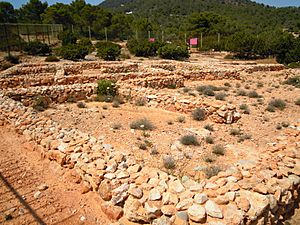Sa Caleta Phoenician Settlement facts for kids

Ruins of the Phoenician settlement of Sa Caleta
|
|
| Location | 10 km (6.2 mi) from Ibiza Town, Ibiza |
|---|---|
| Region | Ibiza |
| Coordinates | 38°52′04″N 1°19′47″E / 38.867778°N 1.329722°E |
| Type | Settlement |
| History | |
| Founded | c. 654–650 BC |
| Abandoned | c. 604–600 BC |
| Site notes | |
| Condition | Ruins |
| Management | Consell d’Eivissa |
| Public access | Limited |
Sa Caleta is an ancient site in Ibiza, Spain. It has the ruins of an old Phoenician settlement. It's on a rocky piece of land about 10 kilometers (6 miles) west of Ibiza Town. The Phoenicians, an ancient people, built this settlement around 650 BC. They left the site by 600 BC.
Archaeologists found the stone foundations of simple buildings here. Because of its importance, Sa Caleta became a UNESCO World Heritage Site in 1999.
Contents
Discovering Sa Caleta's Past
The Phoenicians started arriving on the island of Ibiza around 650 BC. They built this settlement on the rocky land at Sa Caleta. Archaeologists found this large Phoenician settlement in the 1980s and 1990s. The local government helped with the discovery.
The site was named a World Heritage Site in December 1999. It has an urban area with streets and a small square. These areas are called 'neighborhoods' by experts. The first Phoenicians came from the Iberian Peninsula (modern-day Spain and Portugal). They slowly settled here until the whole area became a busy town. It once covered about four hectares (about 10 acres).
What Did They Do for Work?
The Phoenicians chose this spot because it was close to the island's natural salt marshes. Salt was very valuable back then! The shallow pools of seawater in the marsh would dry up under the hot summer sun. This left behind shiny salt crystals. The Phoenicians collected this salt. This was the island's first big business.
The settlers also did other jobs. They went fishing, baked bread, wove cloth, and worked with metal. They used these goods to trade for things they couldn't easily get on the island.
Visiting the Ancient Site
Sa Caleta is on the southwest coast of Ibiza. It's about 10 kilometers (6 miles) from Ibiza Town.
The ancient ruins are protected behind tall iron fences. You can see the restored foundations of several homes. Archaeologists call this area the 'southern quarter' of the settlement. Most of the buildings, about six of them, are grouped around narrow streets and courtyards.
How They Built Their Homes
The main parts of these buildings were made from stone and mud-brick. They had flat clay roofs supported by wooden beams. Most buildings had just one room. These rooms were used for living, working, and storing things.
There's one building in the middle of the site with many rooms. This might have been an important building back then. Its design is similar to other Phoenician homes found around the Mediterranean Sea. It even looks a bit like traditional houses built on Ibiza until recently.
What Happened to the Rest of the Site?
Archaeologists found an organized row of buildings on a terrace near the top of the rocky land. However, this area is not open for public viewing. The settlement used to be larger. Many buildings to the south have been lost due to coastal erosion (when the sea wears away the land).
Sadly, much of the northern part of the site was damaged during the Spanish Civil War. Concrete gun positions, tunnels, and huts were built there in 1937. These were part of the island's defense system. This construction was done without caring for the delicate ancient ruins.
The small cove on the east side of Sa Caleta was once the busy natural harbor for the Phoenician settlers. Today, a few local fishing boats and pleasure boats still use it.
See also

- In Spanish: Yacimiento fenicio de Sa Caleta para niños


